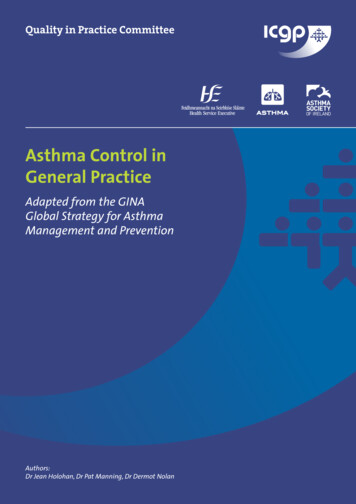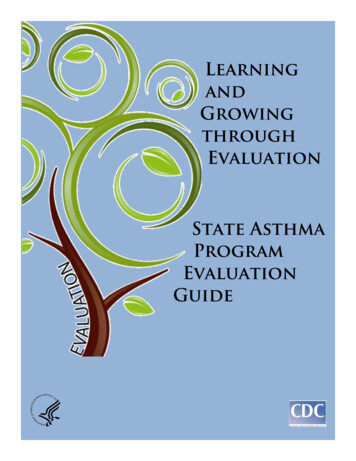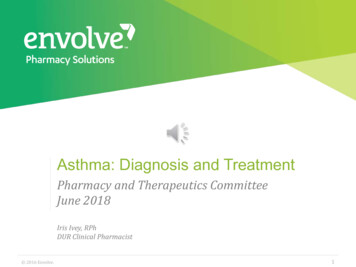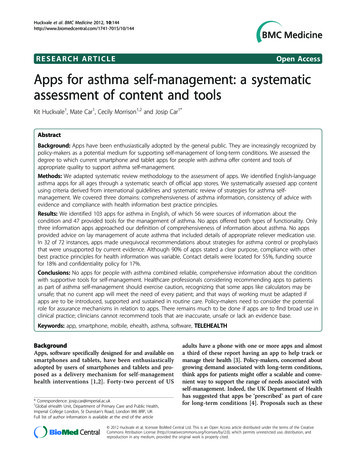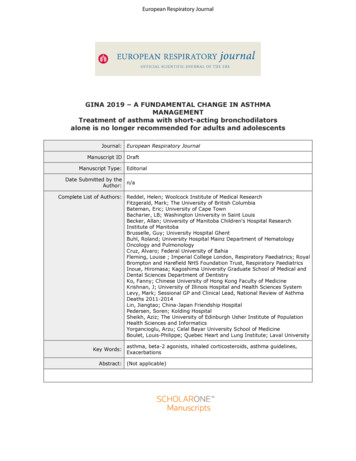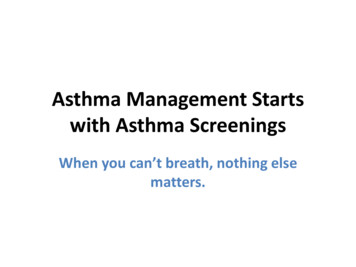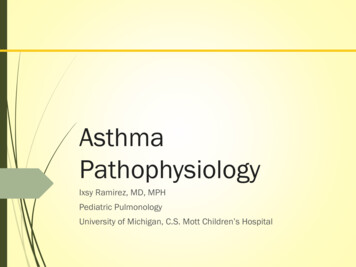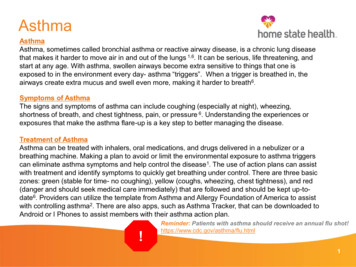
Transcription
CCHCS Care Guide: AsthmaNovember 2021SUMMARYGOALS DECISION SUPPORTPATIENT EDUCATION/SELF MANAGEMENTALERTSClassify patients by asthma severityEnter specific asthma diagnosis on Problem ListManage treatment using NAEPP EPR3-STEPWISE APPROACH1Engage patients in their care with use of Asthma Action Plan andAsthma Control Test (ACT) as indicatedPrevent exacerbations and minimize adverse effects of therapy Poor control: symptoms, SABA use, PEF*, etc. SaO2 92 % Can’t speak more than one to two words per breath PEF 50% predicted or personal best Silent chest, cyanosis, confusionDIAGNOSTIC CRITERIA/EVALUATIONAsthma is a chronic disease that causes narrowing of the airways from inflammation leading to airway obstruction (bronchospasm) and airwayhyper-responsiveness. Classifying the severity of a patient’s asthma is the first requirement in determining the appropriate treatment.SEVERITY CLASSIFICATIONINTERMITTENTSYMPTOM FREQUENCYNIGHTTIME AWAKENINGSSABA* USE FOR SYMPTOMCONTROL (NOTPREVENTION OF EIB )INTERFERENCE WITHNORMAL ACTIVITYSPIROMETRYLUNG FUNCTIONPERSISTENTMILDMODERATESEVERE 2 days/week 2 times/month 2 days/week but not daily3-4 times/monthDaily 1 day/week but not nightlyThroughout dayOften 7 days/week 2 days/week 2 days/week butnot 1 time/dayDailySeveral times per dayNoneMinor limitationSome limitationExtremely limitedNormal FEV1 between exacerbationsFEV1* 80% predictedFEV1 / FVC* normalFEV1 80% predictedFEV1 / FVC normalFEV1 60% predicted but 80% predictedFEV1 / FVC reduced 5%FEV1 60% predictedFEV1 / FVC reduced 5% Exercise-InducedBronchoconstriction (EIB): formerly known as exercise-induced asthma, symptoms occur 5-15 minutes after start of exercise, andcan continue for 10-15 minutes after stop of exercise. The symptoms interfere with performance and EIB usually resolve with 30–60 minutes of rest.EIB may flare when the air is cold. (See page 5)History/Examination including (See page 5): Medications, smoking history, hospitalizations/intubations due to asthma; known triggers; seasonal variability; vaccination history Spirometry if diagnosis in question (Pre and post bronchodilator– should see 12% [and 200 ml] increase in FEV1) Exam including heart and lung, complete vitals (BP, P, RR, SaO 2, T, Ht/Wt). Obtain baseline peak flow (See Attachment A for Peak FlowPredicted Values) and follow-up if signs or symptoms of increased severity of asthma are noted; and as needed Differential diagnosis: other pulmonary diseases, cardiac disease, infectious disease, airway obstruction, etc. Enter Diagnosis on Problem List (i.e., intermittent asthma, mild persistent asthma, moderate persistent asthma, etc.)TREATMENT OPTIONS A basic principle of asthma therapy is that the intensity of treatment should match the severity of asthmatic symptoms Asthma control focuses on reducing impairment (frequency & intensity of symptoms and functional limitations); and reducing risk (the likelihoodof future asthma attacks, progressive decline in lung function, or medication side effects) National Asthma Education and Prevention Program, Third Expert Panel (NAEPP EPR3) 1 recommends first classifying asthma severity, theninitiating therapy using the STEPWISE treatment approach (See page 8) Step up therapy if not well controlled. Review adherence to medications, inhaler technique, and comorbid conditions Step down therapy if well controlled 3 months on current therapy Patient education: help patients identify their triggers and how to avoid them, smoking cessation, proper inhaler use (if indicated), Asthma ActionPlan (See Patient Education PE-4) and Asthma Control Test form (See CDCR 7230, ACT Form) Intermittent Asthma: STEP 1 SABA as needed Persistent Asthma: Daily medication (Consider pulmonary consult if Step 3 care is required) (See detailed steps on page 8)*Definition of Terms: SABA - Short Acting Beta Agonist; LABA - Long Acting Beta Agonist; ICS - Inhaled Corticosteroids; EIB - Exercise Induced Bronchoconstriction;PEF - Peak Expiratory Flow; FEV1 - Forced Expiratory Volume in One Second; FVC - Forced Vital CapacityMONITORING (SEE ALGORITHMS ON PAGES 2 & 3 AND PAGE 9)Follow-up visits: as clinically indicated, but at least every 365 days Assess asthma control and adjust therapy. (See table on page 9) Review medication technique and adherence; assess side effects; review environmental control Consider Asthma Control Test at asthma-related visits Generally, PEFs should be done at every asthma-related visit to document control Review Asthma Action Plan with patient, revise as needed If recent exacerbation, follow closely until patient is clinically improved, and at their baselineTABLE OF CONTENTSAssessment and Treatment Algorithm . 2Acute Exacerbations Algorithm . 3Overview of Asthma . 4Assessment & EIB . 5Classifying Asthma Severity . 6-7Treatment: Stepwise Approach . 8Monitoring . 9Medications . 10-12COPD and Asthma-COPD Overlap Syndrome . 13References . 14Patient Education. PE-1 to PE-4Patient Education Spanish . PE-5 to PE-8Information contained in the Care Guide is not a substitute for a health care professional's clinical judgment. Evaluation and treatment should be tailored to the individual patient and the clinical circumstances. Furthermore, using this information will notguarantee a specific outcome for each patient. Refer to “Disclaimer Regarding Care Guides” for further clarification. http://www.cphcs.ca.gov/careguides.aspx1
CCHCS Care Guide: AsthmaNovember 2021SUMMARYDECISION SUPPORTPATIENT EDUCATION/SELF MANAGEMENTASTHMA: ASSESSMENT AND TREATMENT1-6ASSESSMENT (SEE PAGE 5):History and physical, including PEFConfirm new diagnosis with spirometryPatient education including nursing verification of correct inhaler techniqueIdentify triggers-Seasonal? URI? Allergens?Use ACT form (See CDCR 7230, ACT Form). Can be completed by patient, nurse,or PCP to assess asthma control Reports of Exercise Induced Bronchoconstriction (EIB) alone, without objectiveevidence of EIB, is not an indication for continued use of SABAs or ICS ICS Dosing:Mometasone(Formulary agent- Asmanex HFA ):Strengths; 100 or 200 mcg/puffLow Dose: 100 mcg twice dailyMed Dose: 200 mcg twice dailyHigh Dose: 400 mcg twice daily-Consider tapering to lower dosewhen patient stableASSIGN SEVERIT Y CLASSIFICATION to each patient (SEE PAGES 6-7)(This is done at diagnosis BEFORE starting medications)Document specific classification on Problem ListINTERMITTENT * Symptoms 2 times/wk Nighttime symptoms 2 times/monthAsymptomatic and normalPEF betweenexacerbationsNormal ActivityInterference NoneFEV1 or PEF 80%predicted (% personalbest)SABA use 2 times/weekMILD PERSISTENT Symptoms 2 times/wkbut not daily Nighttime symptomsthree to four times permonth Normal ActivityInterference Minor FEV1 or PEF 80%predicted (% personalbest) SABA use 2 days/wkbut not 1x/dayMODERATE PERSISTENT Daily symptoms Nighttime symptoms 1x/wk Normal Activity Interference Some Exacerbations may last manydays FEV1 or PEF 60% But 80% predicted (% personalbest) SABA use dailySEVERE PERSISTENT Continual symptoms History of intubation or ICUadmission2 hospitalizations in pastyear for asthma Normal Activity Interference Extreme Frequent exacerbations Frequent nighttime symptoms FEV1 or PEF 60% predicted(% personal best) SABA use several times/day INITIAL TREATMENT RECOMMENDATIONS BASED ON SEVERITY (SEE PAGE 8)INTERMITTENTTREATM ENT Generally no ICS,unless seasonal useneeded Rescue SABA twopuffs up to four timesdaily as neededControlled?NOYESMILD PERSISTENTTREATM ENT Low dose continuousICS or considerintermittent use of ICSfor flares Rescue SABA twopuffs, four times daily asneededMODERATE PERSISTENTTREATM ENT Medium dose ICS Rescue SABA two puffsfour times daily as neededSEVERE PERSISTENTTREATM ENT High dose ICS Rescue SABA two puffsfour times daily PRN Consider short-term addition ofLABA (salmeterol one puff twicedaily), or combination ICS LABA (Dulera )*Note Black Box uateclassificationStart ICSunder MildPersistentTreatmentFollow-upclosely withPrimary CareTeam untilstableFollow-upas clinically indicated (atleast annually) withinterval history, clinicalassessment, and PEFwhen lassificationStep up ICSto ModeratePersistentTreatmentStep up ICS toSeverePersistentTreatmentFollow-upclosely withPrimary CareTeam untilstableFollow-upclosely withPrimary CareTeam untilstableYESYESFollow-upas clinically indicated (atleast annually) withinterval history, clinicalassessment, and PEFwhen indicatedABBREVIATIONS:ICS: Inhaled Corticosteroid, PEF: Peak Expiratory Flow. FEV1: Forced Expiratory Volume in one second;EIB: Exercise Induced BronchoconstrictionAdapted for correctional setting: National Asthma Education and Prevention Program Expert Panel Report 3:Guidelinesfor the Diagnosis and Management of AsthmaNOConsidercourse of oralsteroidsConsiderreferral topulmonologyFollow-upvery closelywith PCP untilat baseline,then asindicatedSpirometry ifdiagnosis inquestion2*The Global Initiative for Asthma (GINA) 2021 updates include a new change in the recommended treatment for intermittent asthma, (Step 1 therapy in NAEPP). GINA guidelines states that if the patient uses a combination of a low-doseglucocorticoid-formoterol inhaler “as needed” for asthma symptoms (this is off-label) they may use this ICS-formoterol combination as a “reliever medication” when needed, instead of using a SABA. Per the NAEPP-EPR3 guidelines andUpToDate¹ SABAs the preferred “reliever” option for acute exacerbations in Step 1 therapy. NAEPP et al believe that when symptoms are minor and intermittent, lung function typically normal, the underlying airway inflammation ismild and does not require ongoing ICS treatment.”
CCHCS Care Guide: AsthmaNovember 2021SUMMARYDECISION SUPPORTPATIENT EDUCATION/SELF MANAGEMENTACUTE EXACERBATIONS OF ASTHMAInitial AssessmentBrief history – severity of symptoms, current medications, response toself treatment, time of onset, trigger, and risk factorsPhysical Exam – PEF, heart and respiratory rate, O2 saturation andbreath soundsSigns/Symptoms of Severe ExacerbationUnable to perform PEF or PEF 50% best or predictedBreathlessness (sits upright)Talks in words only, unable to talk in sentences/phrasesUsually agitatedAccessory muscles in useWheezing (usually loud; inhalation & exhalation)SaO2 92% (on room air at sea level)Respiratory rate (often 25/min)Pulse 110 bpmEvaluate exacerbation severitySevere or lifethreatening?1, 7, 9YESSigns/Symptoms of Life Threatening ExacerbationAny S/S of severe asthma AND/ORToo dyspneic to speak; perspiringSilent chest, cyanosis, weak respiratory effortBradycardia, dysrhythmia or hypotensionDrowsiness, exhaustion, confusionNOSigns/Symptoms of Mild to ModerateExacerbationMild: PEF 80% best or predictedModerate: PEF 50-79% best or predictedTalks in phrases; prefers sitting, not agitatedRespiration 25 breaths / minutePulse 110 beats/minuteTreatment:SABA 2-6 puffs with or without spacer* or 2.5 mg bynebulizer every 20 minutes up to 3 dosesOxygen to achieve SaO2 92%Consider oral steroid (Prednisone 40-60 mg daily 5-7 days)Reassess response every 20 minutes for first hourResponse to abovetherapy?NOYESOnce PEF 80% and sustainedresponse for 2-4 hours after lasttreatmentSigns/Symptoms of ModerateExacerbationPEF 50-79% best or predictedContinue SABA 2-6 puffs with orwithout spacer* or 2.5 mg bynebulizer every 20 minutesOxygen to achieve SaO2 92%Oral systemic corticosteroid:Prednisone 40-60 mg po qd for5-7 daysEvaluate if patient stable for return to housing, if so:Continue SABA 2-4 puffs every 4 hours for 1-2days, then as neededConsider oral steroid course (see above)Consider adding or increasing dose of ICSConsider reclassifying severity Ensure patient has rescue SABA InhalerConsider spacerClose follow up with Primary Care Teammember until peak flow back to baseline andpatient stable on usual medication**NOTES:Dosage for oral steroids: Prednisone 40-60 mgorally every day for 5-7 days. No need to tapersteroids if 10 days.*If patient has difficulty using MDI, considerusing spacer.**Patients returning from HLOC/TTA should beseen as per existing CCHCS follow-upstandards.Does patienthave sustainedimprovement (PEF 80%)allowing return to generalpopulationhousing?Arrange Emergency Transport toNearest Hospital (Call 911)Oxygen to achieve SaO2 92%IV AccessPrednisone 60 mg orally statInhaled high dose SABA ipratropium with spacer every20 minutes or continuously viaoxygen driven nebulizerPCP should see patient afterhospital discharge**. Obtainpeak flows and follow closelyuntil back to baseline peakflow and stableNOTransfer to higher level ofcare if not improving orimprovement not sustainedYESContinue SABA every 4-6 hrs as neededContinue oral Prednisone 40 to 60 mg podaily for 5-7 daysConsider adding or increasing dose of ICSConsider reclassifying severityClose follow up with Primary Care Teammember until peak flow back to baselineand patient stable on usual medication**ABBREVIATIONS:ICS: Inhaled CorticosteroidPEF: Peak Expiratory FlowMDI: Metered Dose InhalerReferences: Adapted for correctional setting: National Asthma Education and Prevention Program Expert Panel Report 3: Guidelines for theDiagnosis and Management of Asthma.-UpToDate: Management of acute exacerbations of asthma in adults.-GINA: 2018 Pocket Guide for Asthma Management and Prevention.3
CCHCS Care Guide: AsthmaNovember 2021SUMMARYDECISION SUPPORTOverview of Asthma1, 3PATIENT EDUCATION/SELF MANAGEMENTAsthma is a chronic disease that causes narrowing of theairways. The narrowed airways are caused by inflammationleading to airway obstruction (bronchospasm) and airway hyperresponsiveness from triggers (i.e., inhaled allergens, irritants,Airwayetc.).Hyperresponsiveness Common clinical symptoms seen in patients with asthmainclude: Wheezing, Coughing, Chest tightness, and Shortness of breathinflammationAirway ObstructionClinical SymptomsThe interactions of these features determine the severity of asthma present and how patients will respond to treatment.The National Asthma Education and Prevention Program (NAEPP) Expert Panel Report 3 (EPR3) Guidelines classify asthma by severity as: Intermittent: symptoms 2 days/week Persistent Mild: symptoms 2 days/week but not daily Persistent Moderate: symptoms daily Persistent Severe: symptoms multiple times per dayThe Healthcare Effectiveness Data and Information Set (HEDIS), and other quality of care measures are based on asthma severity, so it is crucialto put a specific diagnosis on the patients’ Problem List. ICD10 does have the categories above which can be selected.Evaluation, Treatment, and Monitoring OverviewThe goal of asthma management is asthma control based on:1. Reducing impairment – decreasing symptom frequency and intensity; and addressing how asthma affects the patients’ daily life2. Reducing risk – decreasing the number of future asthma attacks, lung function decline, and medication side effectsFIRST: Classify ASTHMA SEVERITY in Patients NOT Taking Medications Assess the patient and classify as intermittent OR persistent asthma (Classification of Asthma Severity on page 6-7) If the patient has persistent asthma, is it mild, moderate, or severe?SECOND: Enter ICD10 Diagnosis in Medical Record first on Visit Diagnosis section and “convert” to Problem List(Be specific: i.e., Intermittent, Mild persistent, Moderate persistent, Severe persistent asthma, etc.)THIRD: TREATMENT based on the STEPWISE APPROACH FOR MANAGING ASTHMA (See page 8 & algorithm on page 2) Generally start treatment based on asthma severity classification and follow closely until the patient is stable/at baseline If control is not good, “Step up” treatment, and as the patient improves can “Step down” treatment, especially if triggers have been resolvedFOURTH: MONITORING: ASSESSING ASTHMA CONTROL & ADJUSTING THERAPY– Follow-up visits (See page 9) ACT - includes questions that cover asthma symptoms, interference with normal activity, shortness of breath frequency, rescue inhaler ornebulizer use, and asthma control self-rating scale, replaces the prior Asthma Control Assessment Tool (ACAT). Helpful to use at asthmarelated visits, especially if the patient’s asthma is not at baseline. (See CDCR 7230 ACT Form) Perform Clinical Assessment and obtain PEF with hand-held device (if available) at baseline and then utilize when the patient presents withsymptoms to follow treatment response and identify high risk flare Determine if ASTHMA is Well Controlled, Not Well Controlled, or Very Poorly Controlled—adjust therapy as indicated Follow-up closely until at baseline, and then follow-up as clinically indicated, but at least annually.Differential Diagnosis Young-middle-aged adults with asthma-like symptoms may have:Recurrent bronchitis, bronchiolitis or bronchectasisParadoxical vocal cords (AKA laryngeal dysfunction)Pulmonary embolismGastroesophageal reflux disease (GERD)Panic disorderSarcoidosis (higher incidence in African-Americans)Chronic Obstructive Pulmonary Disease (COPD)Older patients (especially cigarette smokers) may have: COPD and Asthma-COPD Overlap Syndrome (See page 13) Left-ventricular heart failure Sarcoidosis (in addition to above, symptoms can include shortness ofbreath, loss of lung function, and permanent damage) Tumors involving central airways Recurrent oropharyngeal aspiration4
November 2021SUMMARYDECISION SUPPORTAsthma Assessment1, 8-9, 11CCHCS Care Guide: AsthmaPATIENT EDUCATION/SELF MANAGEMENTHistory: Symptoms (can be variable and recurrent): Cough, wheezing, difficulty breathing, chest tightness, are symptoms worse at night? Common triggers—exercise, cold air/seasonal, exposure to inhaled allergens, viral infections Previous history—smoking, asthma as a child, prior asthma medications, hospitalizations/intubations due to asthma, seasonal variability,vaccination history, work-related symptoms, family history of asthma and allergies, atopic symptoms such as atopic dermatitis or allergicrhinitis ACT replaces the previously used ACAT. The ACT is validated and includes questions that cover asthma symptoms, interference with normalactivity, shortness of breath frequency, rescue inhaler or nebulizer use, and asthma control self-rating scale. It is easily scored and then usedto help assess asthma control and make therapy adjustments during follow-up visits. Can be completed by the patient, nurse, or primary carephysician to assess asthma control—baseline and subsequent visits (See CDCR 7230 ACT Form)Physical Exam: is often normal Perform exam including heart and lung (most frequent finding is wheezing on auscultation, especially on forced expiration) Complete vitals (BP, P, RR, SaO2, T, Height-for PEF calculation and weight [if needed for medication dosing]) Obtain baseline peak flow when doing well (consider peak flow at every follow-up visit) (See Attachment A for Peak Flow Predicted Values)PEF Monitoring: The PEF is the maximal rate that a person can exhale during a short maximal expiratory effort after a full inspiration The PEF percent predicted correlates pretty well with the percent predicted value for the forced expiratory volume in one second (FEV1) andprovides an objective measure of airflow obstruction PEF also tends to correlate with the symptoms assessed by the ACT; PEF readings may show a decline in asthma control beforesymptoms are noticed Handheld PEF devices should be available in every clinic; consider using at every asthma-related visitSpirometry should be considered when: making the initial diagnosis of asthma; confirming reversible airflow limitations or excluding alternativediagnoses (Refer to Up To Date Online-Pulmonary Function Testing in Asthma)Patient Education: Teach patients how to manage their asthma. (See Patient Education pages PE-1 to PE-4) Nursing verification of correct inhaler (and spacer if applicable) technique, proper use of hand-held PEF device Self-monitoring to assess level of asthma control and recognize signs of worsening asthma (either symptom or peak flow monitoring) Understanding what triggers their asthma and how they can avoid exposure to these triggers Asthma Action Plan (See PE-4): Teach the patient how to use the plan to proactively control asthma, adjust medications in response toworsening asthma symptoms, and seek medical care when appropriate. Encourage adherence to the plan and review/update as needed Asthma Control Test form (See CDCR 7230 ACT Form)Exercise-Induced Bronchoconstriction (EIB) Assessment1, 12Some patients report bronchospasm/bronchoconstriction only while exercising. In the past this was called Exercise-Induced Asthma. Morerecently, the 2013 American Thoracic Society (ATS) practice guidelines call this condition Exercise-Induced Bronchoconstriction (EIB).EIB is thought to be related to the release of inflammatory mediators including histamine, tryptase and leukotrienes by airway eosinophilsand mast cells; and triggered by aerobic exercise. Diagnosis: Usually based on history, chest tightness, pain, cough, wheezing or shortness of breath which typically occur 10–15 minutes aftera brief episode of exercise or approximately 15 minutes into prolonged exercise. The symptoms interfere with performance and EIB usuallyresolves with 30–60 minutes of rest. EIB may flare when the air is cold. Additional work up may be indicated in equivocal cases. Ifsymptoms persist or are not prevented by SABA use, formal pulmonary function tests may be required and or referral to specialist. EIB ATS Guideline Treatment Recommendations: For patients with EIB, administer an inhaled SABA before exercise (strong recommendation, high-quality evidence). The SABA istypically administered 15 minutes before exercise. For patients with EIB who continue to have symptoms despite using an inhaled SABA before exercise or who require an inhaledSABA daily or more frequently, ATS recommends adding other therapies including: Daily administration of an ICS (strong recommendation, moderate-quality evidence) It may take 2–4 weeks after the initiation of therapy to see maximal improvement Daily leukotriene receptor antagonist is recommended (strong recommendation, moderate-quality evidence) Mast cell stabilizing agent before exercise (strong recommendation, high-quality evidence) Inhaled anticholinergic agent before exercise (weak recommendation, low-quality evidence) Summary: Use SABA 15 minutes before exercise initially. If SABA is used daily or more frequently, then add a daily inhaled ICS or a dailyleukotriene receptor antagonist first (the choice between these agents is made on a case-by-case basis depending upon patient preferencesand baseline lung function). Mast cell stabilizing agents and inhaled anticholinergic agents play a secondary role.5
CCHCS Care Guide: AsthmaNovember 2021SUMMARYDECISION SUPPORT PATIENT EDUCATION/SELF MANAGEMENTClassification of Asthma severity1, 8-9FIRST: Classify ASTHMA SEVERITY in Patients NOT Taking MedicationsAsthma control focuses on two components:1. Reducing impairment—decreasing current symptom frequency and intensity and addressing how asthma affects the patient’s daily life.2. Reducing risk—decreasing the number of future asthma exacerbations, lung function decline, and medication side effects; the risk of futureexacerbations is based on the number of serious exacerbations in the past year.These two components determine whether a patient’s disease burden from asthma is under clinical control. Both these components are used indetermining asthma severity and asthma control. The difference is: Asthma SEVERITY is an assessment of disease intensity before the start of therapy. Asthma CONTROL is an assessment of symptom frequency and lung function once treatment has been started.Once you have determined your patient has asthma determine the severity of the asthma before they are on medications (the severitycategory helps guide which medications to start). The degree of impairment is based on: symptom frequency, number of nighttime awakenings, frequency of SABA use, degree ofinterference with normal activity, and lung function based on office spirometry.The risk of future exacerbations is based on the number of exacerbations over the past year.See chart below for details.Classification of Asthma SEVERITY in Patients NOT Currently Taking Medications(including recently diagnosed patients and those with a past asthma diagnosis not currently on medications)COMPONENTS OFCONTROLSeverity ClassificationSymptom FrequencyMild 2 days/week butnot dailyModerateDailySevereThroughoutdayOften 7days/week3-4 times/month 1 day/week butnot nightlyShort-acting beta2-agonist (SABA)use for symptom control (notprevention of EIB) 2 days/week 2 days/week butnot 1 time/dayDailySeveral timesper dayInterference with Normal ActivityNoneMinor limitationSome limitationExtremelylimitedSpirometryLung FunctionRISK (Over last year) 2 days/weekPersistent 2 times/monthNighttime AwakeningsIMPAIRMENTIntermittentExacerbations requiring systemiccorticosteroidsNormal FEV1betweenexacerbationsFEV1 80%predictedFEV1 / FVC normalFEV1 80%predictedFEV1 / FVC normalFEV1 60%predicted but 80%predictedFEV1 / FVCreduced 5%IntermittentPersistent 1 time/year 2 times/yearFEV1 60%predictedFEV1 / FVCreduced 5%Note: Assign severity to the most severe category in which any feature occurs considering both impairment and risk6
CCHCS Care Guide: AsthmaNovember 2021SUMMARYDECISION SUPPORT PATIENT EDUCATION/SELF MANAGEMENTClassification of Asthma severity (Continued)Intermittent asthma Daytime asthma symptoms occurring two or less days/weekTwo or less nocturnal awakenings/monthSABA use to relieve symptoms no more than two days/weekNo interference with normal activities between exacerbationsPEF or FEV1 when asymptomatic that are consistently within normal limits (i.e., 80% of predicted normal)FEV1 /FVC ratio is normal (based on age-adjusted values) when asymptomaticOnly one or no exacerbations requiring oral glucocorticoids in the preceding yearMildPersistentAsthma Symptoms more than two days/week (although less than daily)Three to four nocturnal awakenings/month due to asthmaSABA use to relieve symptoms more than two days/week (but not daily)Minor interference with normal activitiesFEV1 /FVC ratio is normal (based on age-adjusted values), but FEV1 80% predictedTwo or more exacerbations requiring oral glucocorticoids per yearModeratePersistentasthma Daily symptoms of asthmaNocturnal awakenings more than once/week (although not every night)Daily need for SABA use to relieve symptomsSome limitation in normal activityFEV1 between 60% and 80% predicted and a FEV1/FVC ratio reduced 5%Two or more exacerbations requiring oral glucocorticoids per yearSeverePersistentasthma Symptoms of asthma throughout the dayNocturnal awakenings often 7 times/weekSABA use several times per dayExtremely limited in normal activityFEV1 60% predicted and a FEV1 /FVC ratio 5%Two or more exacerbations requiring oral glucocorticoids per yearAcute exacerbations of asthma1, 7 Asthma exacerbations are acute or subacute episodes of progressively worsening shortness of breath, cough, wheezing, and chesttightness—or some combination of these symptomsExacerbations are characterized by decreases in expiratory airflow the severity of which can be objectively documented by simplemeasurement of lung function (PEF or spirometry)PEF measurements take 1 minute to perform, but require careful instruction to obtain reliable measurementsFor management of asthma exacerbations, see the algorithm on page 3Special populations1, 9 Occupational asthma and work-aggravated asthma: Ask whether asthma symptoms are improved when they are away from work or not;eliminate exposure ASAPPregnant women: Obtain asthma history in all pregnant women and those who are planning to become pregnant; stress the importance ofasthma controller treatment for the health of the mother and babyElderly patients: Asthma may be under-diagnosed due to assumptions that dyspnea is normal in old age; they are not physically fit. Asthmamay be over-diagnosed due to confusion with shortness of breath from left ventricular function or ischemic heart diseaseSmoker and ex-smokers: Asthma and COPD may co-exist or display asthma-COPD overlap in smokersDocument diagnosis/severity on problem listSECOND: Enter ICD10 Diagnosis in Medical Record first on Visit Diagnosis section and “convert” to Problem List. Be specific: i.e., Intermittent, Mild persistent, Moderate persistent, Severe persistent asthma, etc. This affects the Quality ManagementAsthma Registry and the flagging of quality measures based on HEDIS7
CCHCS Care Guide: AsthmaNovember 2021SUMMARYDECISION SUPPORT PATIENT EDUCATION/SELF MANAGEMENTStart Treatment: Stepwise approach for managing asthma1, 9THIRD: Start Treatment: NAEPP EPR3 recommends classifying asthma severity then initiating therapy using the STEPWISE treatment approach.Generally speaking, the approximate relationship between the STEPs and the ASTHMA SEVERITY is as follows: Step 1 used for patients classified as Intermittent (SABA is used on an “as needed” basis ) Step 2 used for patients classified as Mild Persistent (Regular low dose ICS plus as-needed SABA) Step 3 used for patient
LABA (Dulera ) * Note Black Box warning . Strengths ; 100 or 200 mcg / puff Low _ Dose : 100 mcg twice daily Med _ Dose : 200 mcg twice daily High _ Dose : 400 mcg twice daily-Consider tapering to lower dose when patient stable Follow -up as clinically indicated (at
